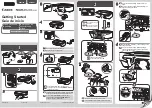
How To Improve Quality When Banding Occurs
Introduction
Banding can occur in an image for a number of reasons. Typically it occurs due to
neighboring nozzles that do not fire or multiple nozzles that fire with poor directionality.
This can occur if the printer sits idle for an extended period of time (e.g., overnight or
longer), or if debris has been picked up from the media or table by a printhead. If this
happens, perform the Printhead Maintenance procedure to clear the affected printheads.
If banding is evident, print a nozzle check to identify which nozzles of a particular print
head are not firing. After you perform the printhead maintenance, print another nozzle
check to confirm whether the problem has been fixed.
If a print shows banding and a nozzle check print shows more than three separate nozzles
out or two or more adjacent nozzles out, the following procedures for recovering clogged
nozzles is recommended to improve image quality.
Note:
Keep the table surface clean and ensure the media is clean and free of dust to help reduce
banding. Use an anti-static brush, if necessary. Also use a micrometer to accurately
measure the media thickness so the proper printhead gap between the printhead and
the media is used. If the printhead gap is less than it should be, there is a greater proba-
bility of picking up debris on the printheads
Recovering Clogged Nozzles
When banding appears in an image and nozzle dropouts appear in the Nozzle Check
print, we recommend that printhead maintenance is performed. In some cases it may be
beneficial to print an image file after maintenance, to exercise the firing of the nozzles,
then run the Nozzle Check again.
If some nozzles are still out, perform a purge of only the printheads with nozzles out. To
do this, close the ink valves of the colors that don't require a purge, then purge to remove
excess inks.
If dropouts still persist, you can also swab the printheads.
Chapter 11 - Error Handling and Troubleshooting
210
How To Improve Quality When Banding Occurs
Summary of Contents for Arizona 400 Series GT
Page 1: ...Oc Arizona 400 Series GT Oc Arizona 440 460 480 GT XT Revision A Oc User Manual...
Page 6: ...6 Contents...
Page 7: ...Chapter 1 Introduction...
Page 14: ...Chapter 1 Introduction 14 Product Compliance...
Page 15: ...Chapter 2 Product Overview...
Page 18: ...Chapter 2 Product Overview 18 Printer Specifications...
Page 19: ...Chapter 3 Safety Information...
Page 41: ...Chapter 4 How to Navigate the User Interface...
Page 71: ...Chapter 5 How to Operate Your Oc Arizona Printer...
Page 97: ...Chapter 6 How to Operate the Oc Arizona 400 Series XT...
Page 104: ...Chapter 6 How to Operate the Oc Arizona 400 Series XT 104 How to Print With Dual Origins...
Page 105: ...Chapter 7 How to Operate the Roll Media Option...
Page 136: ...Chapter 7 How to Operate the Roll Media Option 136 How to Use Media Edge Protectors...
Page 137: ...Chapter 8 How to Use the Static Suppression Upgrade Kit...
Page 141: ...Chapter 9 How to Work With White Ink and Varnish...
Page 198: ...Chapter 9 How to Work With White Ink and Varnish 198 How to Create and Use Quick Sets...
Page 199: ...Chapter 10 Ink System Management...
Page 206: ...Chapter 10 Ink System Management 206 How to Change Ink Bags...
Page 207: ...Chapter 11 Error Handling and Trou bleshooting...
Page 211: ...Chapter 12 Printer Maintenance...
Page 265: ...Appendix A Application Information...
















































